The Motorola Moto G4 and G4 Plus Review
by Brandon Chester on August 15, 2016 8:00 AM EST- Posted in
- Smartphones
- Lenovo
- Motorola
- Moto G
- Moto G4
Battery Life
Regardless of how good a phone's hardware is, if it can't last through the day then it's never going to provide a good user experience. We use a few different tests to analyze the battery performance of a mobile device under different workloads that put a heavy stress on a certain part of the system. In our web test, the workload is display-bound, although there is a significant amount of CPU processing done which will impact results. In GFXBench the test is GPU-bound, and in PCMark the test tries to simulate typical interactions that will make use of all the hardware. For these benchmarks I've opted to just test the Moto G4 Plus, as both the G4 and G4 Plus share the same SoC, display, and battery capacity, so there should be no difference between the two as far as battery life is concerned. As always, I'll start with our own WiFi web benchmark before moving to the battery tests that exist as part of the performance benchmarks that we use.
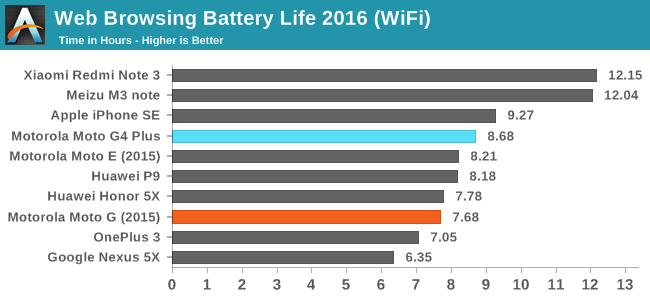
In our internal WiFi web browsing test the Moto G4 Plus lasts exactly one hour longer than the 2015 Moto G. This isn't surprising given the significant increase in the battery capacity with the move to a larger form factor, but it does put to rest any concerns about the Moto G4's higher resolution display leading to worse battery life in display-bound workloads than its predecessors.
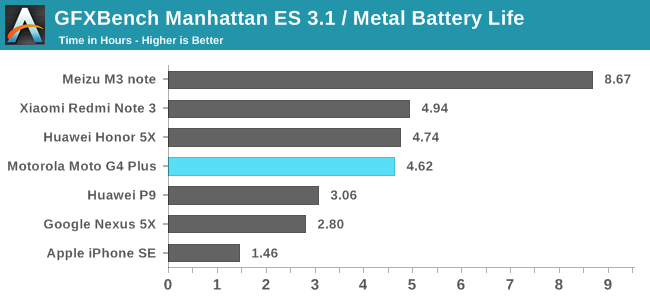
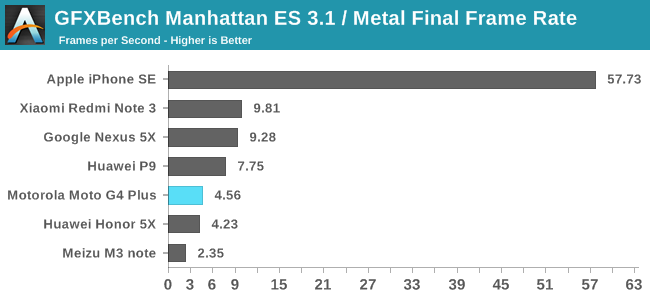
The Moto G4 performs as expected in the GFXBench Manhattan ES 3.1 battery test. Both the runtime and performance are in line with the Huawei Honor 5X, which has essentially the same specifications. Obviously a frame rate of 4.5fps isn't going to be playable, but in a graphical workload more reasonable for the Moto G4's hardware you should be able to play for a good period of time before your battery dies.
Normally I would run PCMark's battery benchmark, which is my favorite battery test because it performs tasks that users do on a daily basis. In my view it provides the best idea of whether or not a phone will last through the day. Unfortunately, I couldn't get the Moto G4 or the G4 Plus to complete the test. Early on in the benchmark it would simply freeze, and the phone would sit there in that state until it drained and died. I attempted the test three times, at which point I gave up on my attempts. The only other device this has happened to is the Google Pixel C, and we all know how that turned out. Suffice to say, this kind of issue is a hint that there are probably other software problems and stability issues in the phone's firmware, and it's not a good sign.
Charge Time
Something that I found to be quite ridiculous about previous versions of the Moto E and Moto G was the charger included in the box. This was market dependent to a degree, but in North America the first problem with the charger was that it had a low power output of roughly 2.5W. This meant that the phones charged incredibly slowly, which was a big problem when paired with the relatively large batteries in the 2015 Moto E and Moto G. On top of that, the charger was a single unit where the block and cord were connected together, rather than being a separate block and cord. This meant that by default, the Moto E and Moto G could not be connected to a computer to transfer media.
While the old charger could be somewhat excused as a cost saving measure, Motorola has clearly recognized the ridiculous nature of it. With the Moto G4 and G4 Plus they now ship a separate cord and charger. Something that confuses me is the fact that Motorola's website explicitly advertises that the G4 Plus ships with their 15W TurboPower charger. While this is the case, the normal Moto G4 unit I received also has it so it's not really a selling point for paying the extra $50 from what I can see. I'm not sure if this differs by market, so it's probably best to check the box when buying to see what charger you get inside.
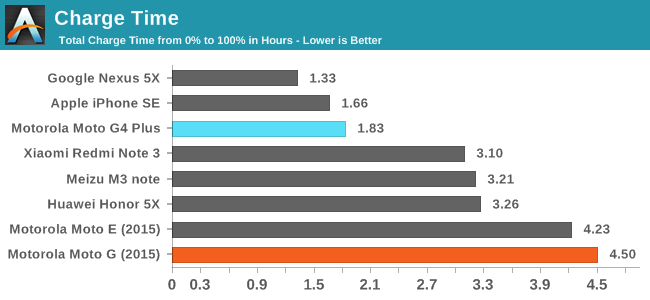
By including a reasonable charger in the box, Motorola has cut down charge time significantly. The 2015 Moto G had the longest charge time on record for a smartphone, while the Moto G4 Plus is in line with what is expected of modern smartphones. Fast charging has more than halved the time it takes to charge the battery fully, despite the fact that the battery has increased in size from 2470mAh to 3000mAh. My only complaint is that Motorola's TurboPower charger makes a whining noise when the phone reaches a full charge and is left connected. I noted this around the time of the Nexus 6 review as it uses the same charger, and I was told by many users that they don't experience this. However, I now have three of these 15W TurboPower blocks and they all do it, so I think it actually comes down to whether or not you can hear the frequency emitted. If you want to look on the bright side, it lets you know when your phone is done charging, but I think I'd rather have an LED indicator instead.


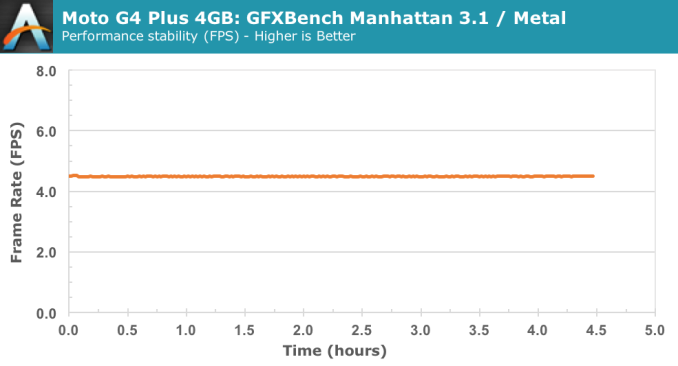
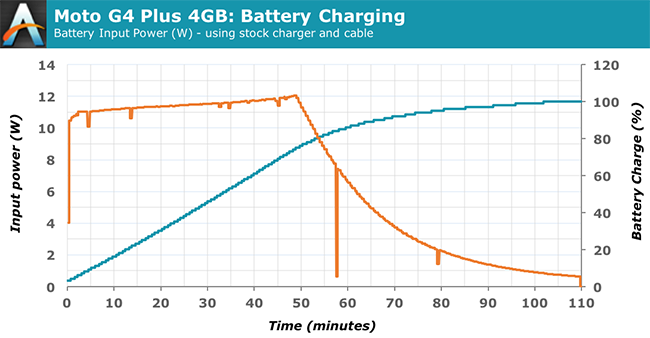








94 Comments
View All Comments
markiz - Tuesday, August 16, 2016 - link
Like, 80% of the time the phone is on it's back on the table.When I'm at work, and want to check out an IM or weather, or whatever, I don't pick it up, almost never. Faster (and stealthier) to keep it laying.
jabber - Monday, August 15, 2016 - link
Don't get why you would brand your phone the same as another G4. Most odd.zeeBomb - Monday, August 15, 2016 - link
Hey Brandon, do you think with the Nexus 5X, the HDR+ mode should be the go to mode like an auto mode for camera shots?grayson_carr - Monday, August 15, 2016 - link
When the 5X and 6P first came out, Anandtech always tested them with HDR+ enabled, but after 6 months or so, they decided that Google should stop being lazy and improve their image processing when not using HDR+ mode, so they started testing without HDR+ mode enabled.Brandon Chester - Monday, August 15, 2016 - link
Yes you should use HDR+. I have since stopped using it in reviews because it's not acceptable to take 1-2 seconds per shot for processing to get a usable image, and because HDR+ introduces exposure problems of its own. The quality of Google's normal processing is several years behind the best smartphones, and they need to do better.zeeBomb - Monday, August 15, 2016 - link
Wow :o from good to problematic in a short span if time...good to know. Thanks!Omega215D - Monday, August 15, 2016 - link
I'd advise against Motorola phones now that they are under Lenovo since the camera module on my Moto Z Force has suddenly worsened after a glitch when switching from regular Photo mode to Professional in which parts of the frame displayed exhibited what looked like broken LCD with top half in green and heavy artifacting and the bottom in red with heavy artifacting. Switching modes got it out of that but now photos taken in lower light settings are worse than my HTC One M8 which wasn't the case befor and Moto is slow to respond to my issue.Badelhas - Friday, August 19, 2016 - link
Yeah, since the "We will not update the Moto E 2015" controversy (8 month old popular smartphone) , Motorola lost all of the confidence I had in the company and I won't be suggesting one of their devices to anyone, ever.Hrel - Monday, August 15, 2016 - link
Sadly they made it bigger, 5.5" is too big. Why wouldn't they just leave it at 5" and do the 1080p screen?Just sad.
greyhulk - Monday, August 15, 2016 - link
Too big for you, maybe. That's the minimum size for me now.